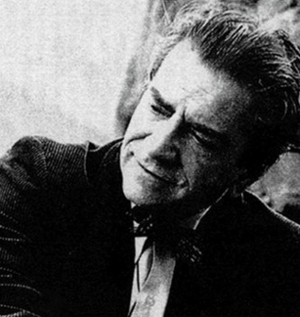Bruno Zevi facts for kids
Quick facts for kids
Bruno Zevi
|
|
|---|---|
 |
|
| Born | 22 January 1918 Rome, Italy
|
| Died | 9 January 2000 (aged 81) Rome, Italy
|
| Alma mater | University of Rome, Harvard Graduate School of Design |
| Occupation | Architecture critic, architect, historian, author |
| Spouse(s) | Tullia Calabi (m. 1940) |
Bruno Zevi (born January 22, 1918 – died January 9, 2000) was an important Italian architect, historian, and writer. He taught about architecture and was known for his strong opinions. He didn't like some styles of modern architecture that looked too old-fashioned.
Contents
Early Life and Studies
Bruno Zevi was born and passed away in Rome, Italy. His family was Jewish.
After finishing school in 1933, he started studying architecture at the University of Rome La Sapienza. In 1938, he had to leave Italy because of unfair laws against Jewish people. He moved to London, UK, and then to the United States. In the US, he studied at the Harvard Graduate School of Design. There, he learned from Walter Gropius, a famous architect.
In 1940, he married Tullia Calabi, an Italian journalist. While in the US, Zevi discovered the work of Frank Lloyd Wright. Wright's ideas about "organic architecture" became very important to Zevi's own work. Organic architecture means designing buildings that fit naturally with their surroundings. Zevi returned to London in 1943.
Promoting Organic Architecture
In 1944, Bruno Zevi started an important group called the Association for Organic Architecture (APAO). The next year, his book Towards an Organic Architecture was reviewed in a magazine. This book helped him become known around the world.
A Professor and Writer
In 1945, Zevi became a professor of architectural history at the University of Venice. Later, he taught at the University of Rome La Sapienza. He was also a member of the International Academy of Architecture (IAA).
From 1955, he wrote a regular column for the weekly L'Espresso magazine. He was also very active in the Italian Jewish community. He took part in groups that were against fascism, like the Giustizia e Libertà movement. He was also involved in politics, serving in the Italian Parliament from 1987 to 1992. From 1954 until he passed away in 2000, he was the editor of his own magazine, L'architettura. Cronache e storia.
His Ideas on Architecture
One of Zevi's most important books is The Modern Language of Architecture. In this book, he shared seven "anti-rules" for understanding modern architecture. He looked at the work of famous architects like Le Corbusier, Gropius, Mies van der Rohe, and Wright.
Instead of old-fashioned rules about perfect balance and order, Zevi suggested a new way to think about buildings. He believed architecture should be:
- Free and creative in its design.
- Focused on differences and interesting contrasts.
- Dynamic, with many different viewpoints.
- Made of parts that work together but also stand out.
- A mix of engineering and beautiful design.
- Designed for how people actually use the space.
- Integrated into its surroundings, fitting in naturally.
Zevi believed that architecture should be complex and interesting, not always simple and uniform. He saw how modern ideas in architecture had roots throughout history.
Space in Architecture
In his book Saper vedere l'architettura (Knowing How to See Architecture), Zevi explained that space is the most important part of a building. He thought that understanding the space inside and around a building helps us truly appreciate its design.
Critic of Classicism
Bruno Zevi was very firm in his views. He didn't like it when modern architecture tried to look like older, classical styles. He even criticized architects he admired, like Gropius, Mies, and Alvar Aalto. He felt that when they made buildings that were too symmetrical, it was like they were giving up on new ideas and going back to old ways.
In 1973, Zevi shared his ideas as a set of "invariants." These were like a guide to modern architecture that favored unevenness and interesting differences. He spread these ideas through his magazine. His exciting theories about architecture being about new breaks and changes made him a key thinker for many modern architects.
See also
 In Spanish: Bruno Zevi para niños
In Spanish: Bruno Zevi para niños


